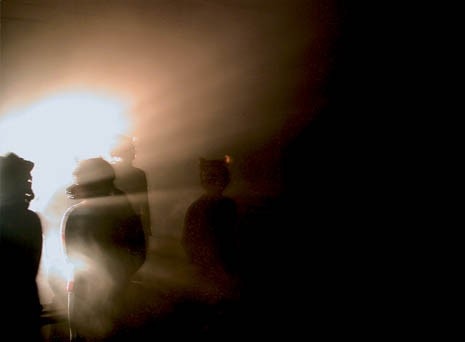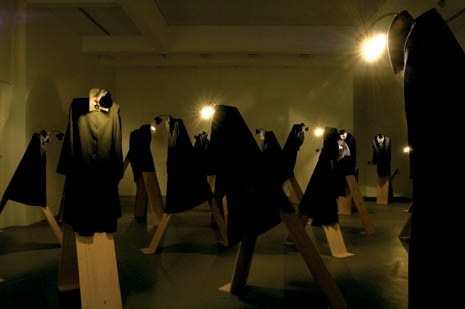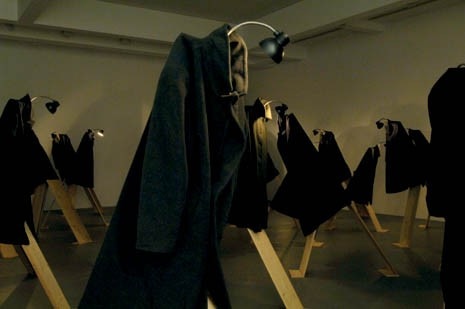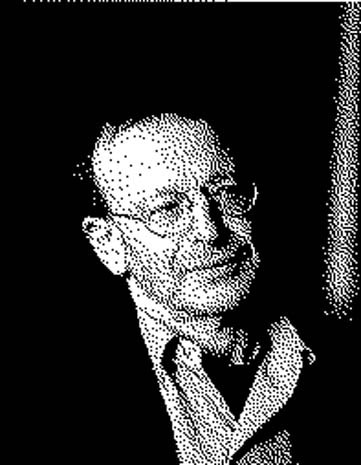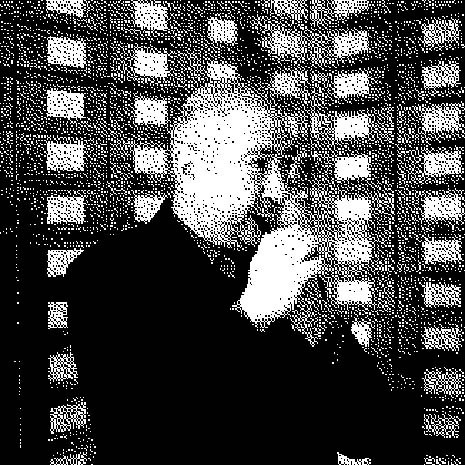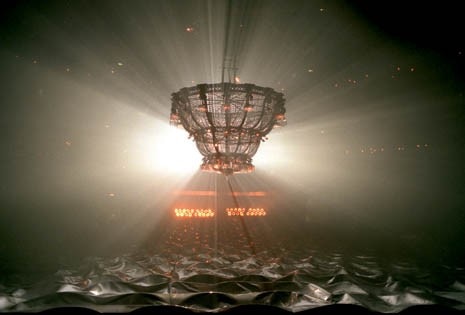Hans Ulrich Obrist You have been working together for a number of years… It is common enough to see two people of different origins and crafts joining forces. But yours is a more original kind of association. To start with, you’ve been collaborating for something like ten years now; and secondly, I think we can say that this work in common has come to mean more than just a collaboration. Am I right in thinking this is something rather special?
Christian Boltanski Yes, I think it can be said that while we each carry on working by ourselves, what we do as a trio, with the musician Franck Krawczyk, is nonetheless more like the work of one person. It is not a situation where this or that painter starts doing sets for this or that producer, it is not about a contingent, selective association. We are looking for something…
HUO In these projects, can one tell who did what, or is that impossible?
CB The work we do together is really a form of ping pong, of unexpected twists and turns. So you see, one of us says something, another says: “no, it would be better like this” and then the third one chips in. So you see, things are reshuffled all the time, and their origins are so varied that it is actually very hard in the end to attribute this or that aspect to any one of us in particular. For Franck it’s rather different, because it is he who writes the music, even though we too have a marked influence on it. If he wants to put in a piano, as happened recently, we can raise objections: “Not a piano, that would be much too cumbersome, we’ve got to find something else but in any case not a grand piano! Because that wouldn’t work…” So by these means we exert an influence on what he can produce. But then he also possesses a remarkable quality: he is very supple. He keeps on inventing things with the greatest of ease. So he is capable of “rebounding”. And if we don’t like the idea of a piano, he comes up with a music box instead, and manages to recompose the piece to accommodate this new element. So you see, in a strange sort of way, we alter his music even if it is of course only he who actually writes it. HUO Franck is a composer, Christian is a painter, but you Jean, how do you describe yourself? Are you an “architect of light”, an “engineer of light”? How would you describe what you do?
JK Simple. When I work on a theatre or opera production, the term most currently used to describe my profession is the English lighting designer. In French we don’t know quite what to call it. We just say “I create lights”…
HUO A point in common with Christian is your shared admiration for Kantor…
CB He was really the best producer in the world, and undoubtedly my favourite artist. I knew him a little but I didn’t work with him… Jean worked with him a bit…
HUO What is it that interests you about him?
CB His work is sublime. I think it is the impact and poverty of the means he used. The fact that he is beyond time, unmarked by any time. His work is totally emotional, as if it were done with almost nothing, even if it involved an enormous effort. Kantor is the opposite of Bob Wilson. They are both great producers of course, but Bob Wilson is perfection that can be seen, whereas Kantor was a perfection that can’t be seen. You got the impression that he had picked up three old tramps and didn’t even get them to rehearse…
JK There was this extraordinary thing about Kantor, that his work was carried out continually on the stage. He made us look at his stage work and enter it quite simply by being there. Kantor was always on stage, he would go up to an actor and move his hand to watch the result. And clearly when he did that, the spectator was with him, in the process of touching that hand. This led to a sort of continual penetration and a circulation of the eye, because he was there. Sometimes he used to get bored, or he would tell us to raise the volume of the music… All these things meant that we really felt part of what was happening, even if we were sitting in rows without doing anything but watch…
CB The big difference between Kantor and other theatre people was that he worked somewhat in the manner of a painter. Apart from the fact, of course, that he himself was a painter anyway. He really only did a single work: it was always the same and at the same time truly a total art. And the music, too, even if it wasn’t he who wrote it, it was he who found it, and all the sets were done by him. He wasn’t at all the kind of stage producer who takes a text and adapts it. He really did the text, and told the story…
HUO Would you mind describing the way you start off on these projects?
CB Most often we start from a building and try to make use of it as a whole, from different angles. It is a work in progress, there isn’t really a beginning and an end. You can even walk around or sit down. When you are in a theatre, usually there is only one thing, only one event. Whereas here there are several situations going on at once. So things here are presented more in terms of a journey, with simultaneous events occurring in spaces that may be in sharp contrast. Sometimes these places meet and sometimes absolutely not. The intention is to stage a possibility of wandering…
JK A performance generally tries to produce a defined sense of time. With a background, beginning and end, and a development that connects these phases together. Even if we know that the audience will be scattered in different parts of the theatre, each member of that audience will nevertheless be placed. So you have, for each person, a definition of time and space that builds up an environment whereby something is offered. Now I think that right from the start we have always tried to get away from the limits imposed by that setting. We have attempted to create an indefinite temporality - hence the walking; and also to break away from the spatial framework imposed by defining the perspective against which the performance is perceived. From the moment when temporality and perspective are exploded, the setting is dissolved. But all that does not prevent a development, I mean a controlled development. And the interesting thing is that this development can be perceived according to different moments and perspectives.
HUO So we can say that you try to break the regularity of that development by creating a multiplicity of scenes. But what actually happens on your different scenes?
CB What we try to convey is a work situated halfway between a musical performance and an installation or a painting, and I’m talking about what happens when people visit a traditional museum. The question is to bring into effect a well-known contrast between the two spheres: music on the one hand, and the art of the time on the other: painting, an art of space. So we play on the properties of the arts of space, for example the surprise effect, such as when you go back into a museum room and see an enormous painting there; and after that, something smaller etc. Then we play similarly on the properties of the arts of the time. As Jean was saying, even if the time is not defined, there is nevertheless an unfolding of time. Because as soon as you have music you have a time; music is something that progresses…
JK We always try to govern the passing of time, which is not aleatory: there are no scattered events that meet or do not meet, by chance: they were thought in a sharply defined sequence that can be approached at any point in its progression. It is there that the possibility of dissolving the setting is situated. For example, a defined phrase like “la marquise va sortir” can be picked up in the middle “…quise va sortir la mar..” and so naturally in this case something different occurs… So to put it very roughly, this is what happens. At any moment you can exit this development and re-enter it again at some other point. This gives rise at the beginning to an infinite complexity, yet it is not an indefinite cloud of events.
HUO Franck is the third man… How did you get to meet him?
CB It was Joséphine Markovits of the Festival d’Automne who introduced him to Jean. He had worked several times at the Festival d’Automne… Frank had reached a stage in his life where he was trying to get away from traditional contemporary music circles, if I may put it that way. He had become more interested in other things and notably in the resumption and rewriting of music by other composers, which is for that matter an old musical tradition. But in his case the idea is to rework the music in such a way as to arrive at the limit where the rewritten work is destroyed. For example, we worked twice on Mahler, and the composer could be recognised, except that Jean took thirty seconds of Mahler and stretched it to three hours! So he had this desire to withdraw a little from electro-acoustic music…
JK My personal impression is that he is in the process of reconstructing a musical writing.
CB This is something we all approve of. There comes a time when institutionalised avant-garde music gets unbearable; and I think that is what happened to him: he felt like dropping all that and finding a different way of composing and another way of working. For Jean I believe that is what has happened, you are a great designer as they say, and you wanted to shake that off. As for me, I was a bit fed up with exhibitions in the classic sense of the word, and was casting around for something different… So between us we managed to find a point in common, despite the differences of our specific professions. That other form is a hybrid, touching on several different areas. It is about music – since Franck creates an actual work of composition – and it is an installation, but it is also theatre… Here you have three people from different horizons, who no longer feel at home in their respective disciplines and who ventured for that reason into the invention of a hybrid form. I think that more or less sums it up, doesn’t it?
JK Yes. But I would add that it is also an exercise in triangular destabilisation. We are an anti-stool. Two legs and the figure breaks, four legs and there is still one that will be too short but three is the right number of legs to strike the balance. Now in the case of us three we do the opposite: we arrive at an exercise in mutual destabilisation…
HUO How did the two of you meet?
CB I had met Jean and he invited me to the Opéra Comique, which at that time had a programme of artists… The idea of the programming of the Comic Opera, which unfortunately came to a halt, was very interesting: a visual artist was supposed to work on the music.
HUO And was it you who organised that?
JK No, not at all. But it was I who put Christian in touch with that project. Conversely, it was as a result of that project that the idea of doing Winterreise came into being with Christian. CB After that we resumed this work on Winterreise in New York, at the Brooklyn Academy of Music. That’s where we started inventing what we had been wanting to do, even though it was more traditional and straight, since it was inside a theatre. I think that was a decisive experience. After that we did Les Belles Endormies at the Festival d’Automne…
HUO There was also an immense installation in Lisbon that I saw, a homage to Heiner Müller.
CB Yes, and then after that we did something in Dresden, at Hellerau in that place linked to utopia. There it was a sort of journey. There was no music but there was a large installation, a journey into that vast, highly charged and ruined place. And then after that we did Berlin.
HUO With Kabakow.
CB That’s right. That, too, was really enormous. The place was beautiful. It was a former sanatorium that was later converted into a Soviet military hospital. And there were pavilions scattered across an immense park. Spectators could walk around in a totally free way, go into the pavilion of their choice and listen to the recorded music.
JK Our basic reference was Wagner’s tetralogy. If you found the right way, you could listen to it from one end to the other. But the funny thing is that word of mouth was so effective that while on the first day we had the standard festival audience, with the usual people who follow these cultural events, on the next day instead, which must have been a Sunday, the whole of Berlin came along with their kids and sausages…It was extraordinary! (laughter)
HUO But was it with O Mensch at Point P in Paris that the projects began to take a different turn, growing more complex and going deeper into this study of the trialogue or the three-legged stool?
JK The Point P was our second collaboration with Franck. We had started working together in Dijon on that pièce entitled Bienvenue, which was a very fine pièce, very concentrated, where we each explored one another, trying out the possibilities of being together. But it was in effect with Point P that the work achieved a proper scale of complexity. But that was still only a beginning…
HUO Do you think this could be described as approaching a Gesamtkunstwerk? Is there not something of the “total artwork” about this association of installation, light and sound?
JK I may be wrong, but my feeling is that the Gesamtkunstwerk connotation is about an activity aimed at a closed, finished work, so that even if it mobilises a variety of media it does so through a single perspective and through a defined temporality. Whereas we are looking for an open totality, we want to explode the framework and let the spectators into the work.
HUO And what is the spectator’s role? Do you subscribe to Duchamp’s formula whereby it is he or she that creates at least half the work of art?
CB We want the spectator to become an actor. The displacement of the spectator’s body within the performance is part of that performance. For it is their aleatory displacement that causes an essential part of it to exist. We don’t like to have too much of an audience but neither do we like to have none at all. If we were to affiliate that to the art world we would probably need to be looking at the experiments carried out by McCarthy and Mike Kelley, even though they have a completely different vocabulary and an entirely different universe. In fact I think the essential point about the spectator is that basically we want him or her not to be a spectator any more but a participant who participates because he is “inside the work”, not in front of it. When a spectator visits an exhibition, most of the time they are in front of the work, whereas putting them inside it is like pushing what is called an “installation” to the extreme. For example one of the things that Jean and I are very interested in is the changing of space. Moving into a narrow corridor, going down three steps; these things are really very corporal, very physical. As experimented by Bruce Naumann twenty years ago, albeit in a completely different way.
HUO It’s therefore an experience that engages the whole body…
CB That’s right. When you go to the theatre, you don’t really have a physical experience, because you are looking, and things develop at a distance. You must want to cough because there is smoke, you need to feel the wind, to be cold, to be afraid, to feel uncomfortable in a very narrow place, or conversely, to feel freed when stepping into a very wide space.
HUO In your collaboration, since by now so many things have been accomplished, do you envisage any unrealised forms of collaboration? Utopian things, too big to be realised? Projects that are too expensive, or maybe even censured ones?
JK First of all, to go back to your question about our collaboration, an essential element is that of its being a ramble, a stroll. The whole rhythm of these projects, for example the Point P or the work done in Dijon, is marked by this sauntering mood. Inside, the people walk at their own pace. They shuffle, sit down, or don’t do anything particular; they are not instructed and are never forced to do anything at all. We refuse to tell them: “look at that, how interesting!”, “music is being played in a room, so go and look inside…” etc. This atmosphere also surrounds our works because we approach them in that way. And since we drift from one project to another, we can’t have any “project for a project”… (laughter)
CB Yes. Supposing we had to do something here, at the Lutetia Hotel, that is certainly how it would happen. We would be sitting here having a drink, we would look around and end up saying to ourselves that that is where we will do something. And it is starting from that situation that our desire to do something here would come into being…
JK We have not proved to be all that active as regards projects… I think there is one project though, in Paris, which would be worth carrying out: and that is the big concert of bells that we wanted to put on for the Châtelet.
CB Yes, because it would be dreadfully complicated to convince all the parish priests… The idea is roughly as follows: around Châtelet there are for or five churches; there is Notre Dame not far away, etc. At a given moment all these churches would have to ring their bells together in a sort of concert. We would actually write something specific. So you would be on the theatre terrace and you’d hear four or five churches…
JK Or even more! The ideal would be to bring in all the big churches of Paris… But we realised that while this could be done in a small town with pedestrian precincts, it was much more problematic in Paris, because of the noise. So I’m afraid this is likely to remain a utopian dream…
Christian Boltanski, born in Paris in 1944, lives and works in Malakoff. Self-taught, he started painting in 1958 but the artistic turning point in 1967 led to the creation of the dossiers that became one of his principal themes: biographies mixing objects that are not always his and photographs that are often retouched. All his works focus on memory, childhood and the dead, on his own story and that of the community.
Jean Kalman, born in Paris, has worked as a lighting designer for the theatre and opera since 1979 in France, Great Britain, Germany, The Netherlands, Italy, the United States and Japan. In 1991 he received the Lawrence Olivier Award for best lighting designer. He has worked on the creation of installations with, among others, the composer Heiner Goebbels and the artists Christian Boltanski (Winterreise, Les Belles endormies), Karel Appel and Georg Baselitz.
